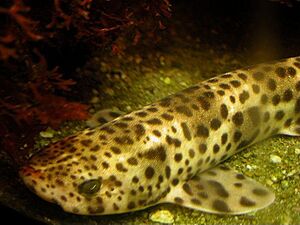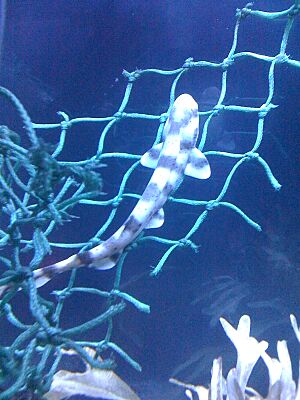Nursehound facts for kids
The nursehound (Scyliorhinus stellaris), also called the large-spotted dogfish or bull huss, is a type of catshark. It belongs to the shark family called Scyliorhinidae. You can find this shark in the northeastern Atlantic Ocean.
Quick facts for kids Nursehound |
|
|---|---|
 |
|
| Conservation status | |
| Scientific classification | |
| Genus: |
Scyliorhinus
|
| Species: |
stellaris
|
 |
|
| Where the nursehound lives | |
| Synonyms | |
|
Scyllium acanthonotum* De Filippi, 1857 * ambiguous synonym |
|
These sharks usually live among rocks or algae. They are found at depths of about 20 to 60 meters (66 to 197 feet). A nursehound can grow up to 1.6 meters (5.2 feet) long. It has a strong body with a wide, rounded head. It also has two dorsal fins located far back on its body.
The nursehound looks a lot like its relative, the small-spotted catshark. However, you can tell them apart. Nursehounds have larger spots. Also, the skin flaps near their nose do not reach their mouth.
Nursehounds are nocturnal, meaning they are active at night. During the day, they often hide inside small holes. They sometimes share these hiding spots with other nursehounds. This shark is a benthic predator, which means it hunts on the seafloor. It eats many kinds of bony fishes, smaller sharks, crustaceans like crabs, and cephalopods like squid.
Like other catsharks, the nursehound lays eggs. Females lay large, tough egg cases, usually two at a time. This happens from March to October. They attach these egg cases to bunches of seaweed. The eggs take 7 to 12 months to hatch.
People in some European countries eat nursehounds. They are sold under different names like "flake" or "rock salmon." In the past, their rough skin was used like sandpaper. The International Union for Conservation of Nature (IUCN) says the nursehound is a "Vulnerable" species. This is because its numbers in the Mediterranean Sea have dropped a lot due to too much fishing.
Contents
About the Nursehound
The first scientific description of the nursehound was written by Carl Linnaeus. This was in 1758, in his book Systema Naturae. He named it Squalus stellaris. The word stellaris is Latin for "starry," because of its spots.
Later, in 1973, this species was moved to the genus Scyliorhinus. The common name "nursehound" comes from an old belief. English fishermen thought this shark "nursed" or looked after its smaller relatives. The name "huss" might be a changed version of "nurse."
Where Nursehounds Live
The nursehound lives in the northeastern Atlantic Ocean. Its range goes from southern Norway and Sweden down to Senegal. This includes the waters around the British Isles, the entire Mediterranean Sea, and the Canary Islands. Some records suggest it might live as far south as the Congo River. However, these might be other similar shark species.
Their habitat seems to be a bit spread out. Especially around islands, there are small groups that don't mix much. Nursehounds can be found from the shallow intertidal zone down to 400 meters (1,300 feet) deep. But they are most common between 20 and 60 meters (66 and 197 feet).
This shark lives on the bottom of the ocean. It likes calm water with rocks or algae. In the Mediterranean, it prefers areas with algae-covered coral.
What Nursehounds Look Like
A nursehound can grow up to 1.6 meters (5.2 feet) long. However, most are shorter than 1.3 meters (4.3 feet). This shark has a wide, rounded head and a strong body. Its body gets thinner towards its tail.
Its eyes are oval-shaped. They have a thick fold of skin on the lower edge. Unlike the small-spotted catshark, the large skin flaps near its nose do not reach its mouth. The nursehound has small gill slits, with five pairs. The last two pairs are above the bases of its pectoral fins.
The two dorsal fins are located far back on the body. The first dorsal fin is larger than the second. In males, the inner edges of the pelvic fins are joined together. The caudal fin (tail fin) is wide and almost flat. It has a small lower part that is not very clear.
The skin of the nursehound is very rough. This is because it's covered in large, upright scales called dermal denticles. The shark's back and sides are covered in small black dots. It also has brown spots of different shapes, which are larger than its pupils. The background color is grayish or brownish.
The pattern of spots can be very different from one shark to another. Some might have white spots. Others might have so many brown spots that their body looks almost completely dark. Some even have faint "saddle" markings across their back. The underside of the nursehound is plain white.
Life and Habits
Nursehounds are mostly active at night. During the day, they hide inside small holes in rocks. At night, they swim into deeper water to hunt. Sometimes, two sharks will squeeze into the same hole. Several nursehounds might also use hiding spots in the same area.
One study tracked a young nursehound. It used five different hiding spots over 168 days. It kept returning to each spot for several days before moving on. Nursehounds might hide to avoid predators or other bigger sharks. They might also do it to help control their body temperature. When kept in aquariums, these sharks like to rest in groups. However, the sharks in a group often change. This species is not as common as the small-spotted catshark.
What Nursehounds Eat
The nursehound eats many different animals that live on the seafloor. These include bony fishes like mackerel, dragonets, and herring. They also eat smaller sharks, such as the small-spotted catshark.
Their diet also includes crustaceans, especially crabs, but also hermit crabs and large shrimp. They also eat cephalopods like squid. If they get the chance, these sharks will also eat dead animals. Adult nursehounds eat more bony fish and cephalopods. Young nursehounds eat more crustaceans.
Some tiny parasites that live on nursehounds include certain flatworms and copepods. The netted dog whelk (a type of sea snail) eats nursehound eggs. It pierces the egg case and sucks out the yolk.
Life Cycle and Reproduction
Like other catsharks, the nursehound lays eggs. Some known places where they breed are the River Fal estuary and Wembury Bay in England. They also breed in several coastal areas around Italy.
Adult sharks move into shallow water in spring or early summer. They mate only at night. The eggs are laid in shallow waters from March to October. A female can produce many eggs each year. However, she usually lays between 9 and 41 eggs.
The eggs grow and are released two at a time, one from each side. Each egg is inside a thick, dark brown case. These cases are about 10 to 13 cm (3.9 to 5.1 inches) long and 3.5 cm (1.4 inches) wide. The cases have string-like parts at the four corners. The female uses these to attach the egg cases to bunches of seaweed.
Eggs in the North Sea and Atlantic take 10 to 12 months to hatch. Eggs from the southern Mediterranean hatch faster, in about 7 months. When they hatch, the young sharks are about 16 cm (6.3 inches) long off Britain. Off France, they are 10 to 12 cm (3.9 to 4.7 inches) long.
Newly hatched sharks grow about 0.45 to 0.56 mm (0.018 to 0.022 inches) per day. They have clear saddle markings on their bodies. Nursehounds become ready to reproduce when they are about 77 to 79 cm (30 to 31 inches) long. This happens when they are about four years old. This species can live for at least 19 years.
Nursehounds and Humans
Nursehounds are generally not harmful to humans. However, a naturalist in the 1800s noted that they can defend themselves. If you grab one, it can wrap its body around your arm. Then, it uses its rough skin like a rasp to scrape you. This can cause painful scratches.
Many public aquariums display this shark. They adapt well to living in captivity and have even reproduced there.
Uses of Nursehounds
The rough skin of the nursehound was once very useful. It was called "rubskin." People used it to polish wood and alabaster. It was also used to smooth arrows and barrels. It could even raise the hairs on beaver hats, replacing pumice. Rubskin was so valuable that one pound of it was worth a hundred pounds of sandpaper.
The liver of the nursehound was used to make shark liver oil. The rest of the shark's body was cut up and used as bait for crab traps. The meat of this shark is sold fresh or dried and salted. Some people think its meat is "coarse."
In the United Kingdom, it is sold as "flake", "catfish", "huss", "rock eel", or "rock salmon". In France, it's called grande roussette or saumonette. This is because after its skin and head are removed, it looks a bit like salmon. Sometimes, this species is also made into fishmeal. Its fins are dried and sent to Asian markets.
In European waters, France catches the most nursehounds. The UK and Portugal also catch a lot. They are caught using fishing methods like bottom trawls, gillnets, and longlines. In 2004, about 208 tons of nursehounds were caught in the northeastern Atlantic.
Conservation Status
It's hard to know exactly how fishing affects the nursehound. This is because data for this specific species is often missing. The nursehound is more likely to be overfished than the small-spotted catshark. This is because it's larger and its groups are spread out. This makes it harder for their numbers to recover if they drop.
There is proof that their numbers have gone down a lot. This has happened in the Gulf of Lion, off Albania, and around the Balearic Islands. In the upper Tyrrhenian Sea, their numbers have fallen by over 99% since the 1970s. Because of these declines, the International Union for Conservation of Nature (IUCN) has listed the nursehound as Vulnerable. This means it faces a high risk of becoming extinct in the wild.






